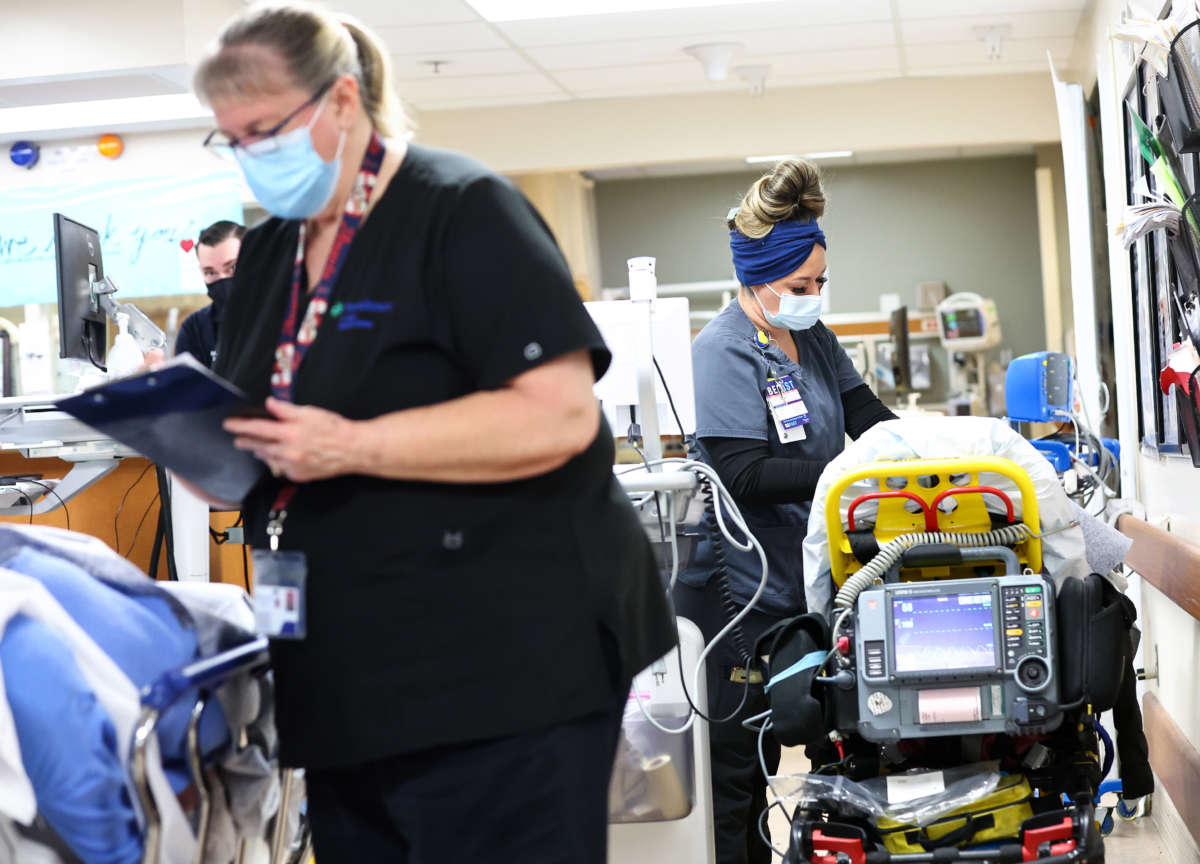Did you know that Truthout is a nonprofit and independently funded by readers like you? If you value what we do, please support our work with a donation.
American citizens pride themselves for living in a country that most of them believe is superlative — freest, most powerful, most entrepreneurial. Yet despite the spheres where it has high standing, the United States ranks dismally among its peer nations when it comes to deaths from COVID-19. “Dismal” might not be a strong enough adjective, actually: the U.S. ranked dead last among its peer nations, with the most deaths per capita.
The data comes from a new study published in the medical journal JAMA, which also analyzed state-by-state vaccination and public health data. Alarmingly, researchers noted that if every state in the United States had the same vaccination rates as those states with the highest vaccination rates, more than 100,000 lives would have been saved.
Led by researchers from the Brown University School of Public Health and the University of Pennsylvania Perelman School of Medicine, the JAMA study compared data on vaccinations and COVID-19 mortality in 2021 and 2022 between the United States and the 20 other most populous countries in the Organisation for Economic Co-operation and Development (OECD). Not surprisingly, the per capita death rate was higher in America than any of those other 20 countries during the delta and omicron waves in 2021 and 2022, with America accumulating 370,298 COVID-19 fatalities in total.
Yet the data was particularly illuminating when the authors compared the ten US states with the highest vaccination rates with those that had the lowest vaccination rates.
According to the JAMA study, the per capita rate of COVID-19 deaths in the 10 states with the highest vaccination rates (73%) was 75 deaths out of every 100,000 people. By contrast, the 10 states with the lowest rates of vaccination (52%) had a per capita death rate of 146 out of 100,000 people.
But on an international scale, the numbers looked bad, too. The 10 most vaccinated states had an excess all-cause mortality rate that was equal to or less than that of several other OECD countries (including Denmark, Germany, Italy, the Netherlands, Austria and Finland). The phrase “all-cause mortality rate” refers to the total death rate, based on all causes of death, within a total population for a given period of time. That number is meaningful because many deaths that were, on paper, from other causes were indirectly caused by COVID-19.
“From June 27, 2021, to March 26, 2022, the US would have averted 122,304 deaths if COVID-19 mortality matched that of the 10 most-vaccinated states and 266,700 deaths if US excess all-cause mortality rate matched that of the 10 most-vaccinated states,” the authors conclude. “If the US matched the rates of other peer countries, averted deaths would have been substantially higher in most cases (range, 154,622 – 357,899 for COVID-19 mortality; 209,924 – 465,747 for all-cause mortality).”
This means that, if the 10 states which had the fewest number of vaccinated citizens had been inoculated at the rates of the 10 states with the highest percentage of vaccinated citizens, roughly 122,000 people who died of COVID-19 during the nine-month period covered by the study would have lived instead. Similarly, if throughout the United States the total amount of excess deaths from all causes had been the same as in the 10 most highly-vaccinated states, more than 266,000 deaths would have been avoided.
The United States’ dismal public health ratings owe a debt to the haze of vaccine misinformation that pervades the United States, and which has become dogma among some right-wing politicians who have encouraged the spread of public health misinformation for political gain. Although anti-vaccine conspiracy theories became increasingly popular due to the COVID-19 pandemic, they long preceded it. In 1998, soon-to-be-discredited doctor Andrew Wakefield published a case series which claimed that the measles, mumps and rubella vaccine (MMR vaccine) was linked to the development of autistic traits in young people. A panic ensued until it became clear that Wakefield’s paper was riddled with problems: It had no data about the MMR vaccine, included speculative conclusions, only reviewed a small sample of patients and used a poorly-designed experimental model. It later came out that Wakefield also had financial conflicts of interest which he had not disclosed when publishing the study.
Anti-vaccine ideas became more prevalent in the 2020s after the COVID-19 pandemic reached the United States. Popular podcaster Joe Rogan touted supposed COVID-19 treatments that did not work, such as the horse de-wormer ivermectin. Rogan’s ideas spread thanks to other anti-vaccine celebrities such as quarterback Aaron Rodgers.
There is no scientific evidence indicating that purported COVID-19 treatments like hydroxychloroquine, ivermectin, vitamin C and vitamin D are effective in stopping COVID-19 infections. While monoclonal antibodies can be effective, and Paxlovid works well, both are second-line defenses that are much more likely to be given to the unvaccinated when they contract the virus, as unvaccinated persons typically have far worse outcomes if and when they contract COVID-19.
Press freedom is under attack
As Trump cracks down on political speech, independent media is increasingly necessary.
Truthout produces reporting you won’t see in the mainstream: journalism from the frontlines of global conflict, interviews with grassroots movement leaders, high-quality legal analysis and more.
Our work is possible thanks to reader support. Help Truthout catalyze change and social justice — make a tax-deductible monthly or one-time donation today.
